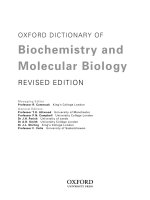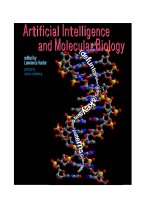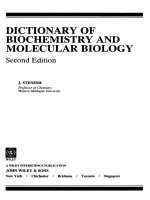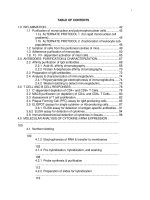Practical test 1 cell and molecular biology
Bạn đang xem bản rút gọn của tài liệu. Xem và tải ngay bản đầy đủ của tài liệu tại đây (688.51 KB, 9 trang )
IBO2012
SINGAPORE
CELL & MOLECULAR BIOLOGY PRACTICAL TEST 1
23rd INTERNATIONAL BIOLOGY OLYMPIAD
8
th
– 15
th
July, 2012
SINGAPORE
PRACTICAL TEST 1
CELL & MOLECULAR BIOLOGY
Total points: 100
Duration: 90 minutes
Page 1 of 9
Country: _____________________ Student Code: ________________
IBO2012
SINGAPORE
CELL & MOLECULAR BIOLOGY PRACTICAL TEST 1
Dear Participants
• In this test, you have been given the following task:
Task: Gene mapping by restriction endonuclease digestion of DNA fragments
Part A. Confirmation of insertion of human DNA in a cloning plasmid. (80 points)
Part B. Determination of orientation by which the fragment was inserted. (20 points)
• Use the Answer Sheet, which is provided separately, to answer all the questions.
• The answers written in the Question Paper will NOT be evaluated.
• Write your answers legibly in ink.
• Please make sure that you have received all the materials and equipment listed for each task. If
any of these items are missing, please raise your hand immediately.
• Stop answering and put down your pen IMMEDIATELY when the bell rings.
• At the end of the test, place the Answer Sheets and Question paper in the envelope provided.
Our Assistants will collect the envelope from you.
Have fun and Good Luck!
Page 2 of 9
IBO2012
SINGAPORE
CELL & MOLECULAR BIOLOGY PRACTICAL TEST 1
Materials and equipment:
Materials and equipment Quantity Unit
restriction endonucleases RE1 (Ndel) (kept on ice)
4 µl
tube
restriction endonucleases RE2 (EcoRl) (kept on ice)
4 µl
tube
DNA test samples in enzyme buffer (labelled T) (on ice)
10 µl x 4
tube
miliQ water (labelled W) 1 tube
DNA electrophoresis gel tank and power supply 1 set
micropipetters and tips in boxes (p10, p100) 2 piece
stopwatch 1 piece
DNA ladder (as internal size markers, L1 for 100 bp range and
L2 for 1 kbp range) (on ice)
2 tube
DNA loading dye (blue in colour) 1 tube
pre-cast gel in holder (already placed in running buffer) 1 piece
large petri dish (for placing the gel for imaging purposes) 1 piece
card with your country code (in a clip holder): for signalling for
assistance
1 piece
floating rack (labelled with your country code) 1 piece
micro-centrifuge 1 set
water-bath 37 ºC (there is one assigned for your usage) 1 set
gel doc (there is one assigned for your usage) 1 set
Page 3 of 9
IBO2012
SINGAPORE
CELL & MOLECULAR BIOLOGY PRACTICAL TEST 1
Task (100 points)
Gene mapping by restriction endonuclease digestion of DNA fragments
Introduction
Genetic mapping is routinely used in analysing the order and the identities of DNA fragments. This
technique is based on the unique profiles of DNA fragments generated after DNA digests with
specific combination of restriction endonucleases and revealed by DNA gel electrophoresis. It is
extremely powerful for gene cloning, studying gene function and regulation, for finding candidate
genes for diseases and their diagnosis and also as a forensic tool.
Part A. Confirmation of insertion of human DNA in a cloning plasmid. (80 points)
Using this technique, you are now tasked to confirm that a fragment of human DNA “X”
(approximate size: 760 base pairs) has been inserted into a cloning plasmid or vector “V” (circular
and approximate size: 2570 base pairs). You are required to design and carry out DNA digests by
incubating DNA “T” with the restriction endonucleases by following the general protocol of
incubation and electrophoresis given (details described below). After the gel electrophoresis, your
results will be revealed by DNA staining (this will be performed by lab technicians), analysed and
data interpreted.
Protocol and Procedures
1. Design your DNA digests (you may do a maximum of 4 sets) in a total volume of 20 µl by using
the Table in the Answer Sheet.
Q1.1 (20 points) Record the desired amounts of reagents in your plan. One example is
already given for Tube 2 in the table provided. All units are in µl.
Page 4 of 9
IBO2012
SINGAPORE
CELL & MOLECULAR BIOLOGY PRACTICAL TEST 1
2. Prepare the mixtures by carefully pipetting the correct amount of the reagents and gently mix
them by pipetting them up and down in each tube. Do not contaminate one sample with
another when preparing the mixture. Use a clean pipette tip for each operation. Note: use p10
micropipetter (silver-coded) for pipetting reagents of less than 10 µl. [NOTE: there will be a
penalty of 20 points if additional samples are requested. Please prepare the samples carefully.]
3. Spin down the mixture by placing all four tubes in the micro-centrifuge (please balance the spin
by placing tubes opposite to each other). During preparation and after spinning, always keep
the tubes on ice.
4. After all the tubes have been prepared, remove them from the ice and place them into the
labelled floatation rack and incubate them for 20 minutes (stopwatch is provided) at 37 ºC in the
water bath assigned to you. Make sure that you retrieve your own samples after the 20
minutes’ incubation time.
5. During this 20 minute incubation duration, answer the following questions in the Answer
Sheet:
Q1.2 (2 points × 5 = 10 points) Indicate true statement(s) with a tick () and false
statement(s) with a cross ().
a. Each RE cuts DNA at unique sequence.
b. Each RE cuts DNA at the 3’ or 5’end of the DNA sequence.
c. RE are most effective in digesting DNA under cold temperature.
d. RE can be kept at room temperature for long term storage.
e. Unlike exonucleases, RE cut only the internal part of DNA.
Page 5 of 9
IBO2012
SINGAPORE
CELL & MOLECULAR BIOLOGY PRACTICAL TEST 1
Q1.3 (2 points × 5 = 10 points) Which of the following principles is true of separating DNA
by gel electrophoresis? Indicate true statement(s) with a tick () and false statement(s)
with a cross ().
a. DNA fragments are overall positively charged.
b. The smaller DNA fragments move faster across the gel under the electric current.
c. The smaller DNA fragments are lesser charged than the larger fragments hence
they move faster across the gel.
d. The relative density of the gel matrix affects how long the separation takes.
e. The voltage applied to the electrophoresis is determined by how much DNA is
loaded in the gel.
6. When the 20 minutes of DNA digests duration is up, retrieve your own tubes from the water
bath.
7. Add 4 µl of DNA loading-dye (blue colour). Mix them well by pipetting the mixture up and down
and spin down any residual liquid using the micro-centrifuge.
8. Using the p100 micropipetter (yellow-coded), load 15 µl of the sample mixture of DNA digests
with the loading dye into the “wells” of the agarose gel provided. Make sure that you position
the pipette tips carefully on top of the wells and gently deliver the mixture to the wells without
spilling them. Load 15 µl of each of the Markers, L1 and L2. Add your samples according to
the following scheme of lanes, starting from the left end of the gel.
Marker L1 Tube 1 Tube 2 Tube 3 Tube 4 Marker L2
9. Cover the gel lid and connect the power supply to run at 100 volts for 20 min. Please be careful
and do not touch any part of the electrodes and power supply.
Page 6 of 9
IBO2012
SINGAPORE
CELL & MOLECULAR BIOLOGY PRACTICAL TEST 1
10. Check regularly that the samples have entered the wells and are indeed running towards the
positive electrode. If you need help from the technicians to ensure proper runs for the samples,
please signal for assistance by clipping your signal card at the edge of right wall of your cubicle.
11. While waiting for the gel run, answer the following questions in the Answer Sheet:
Q1.4 (20 points) Consider the following scenario: A piece of linear human DNA (1 kbp) was
digested by a particular enzyme RE3, resulting in 2 fragments of 650 bp and 350 bp.
The same piece of 1 kbp DNA was digested with another enzyme RE4, releasing 2
fragments of 800 bp and 200 bp. And when this 1 kbp DNA was digested with RE3 and
RE4 together, 3 fragments of DNA were generated, 650 bp, 200 bp and 150 bp.
Sketch a linear map of this piece of DNA by indicating the position of RE3 and RE4
digests in the space provided. An example of such a sketch is provided below as a
guide.
12. When the 20 minutes of gel running time is up, turn off the power supply and remove the lid of
the gel tank. Carefully remove the gel (still on the gel tray) and place it on the petri dish
provided. Bring your gel to the gel doc that has been assigned for your usage and the
technician will photograph it for you.
13. Bring your gel and the photograph back to your cubicle and use your signal card to get
assistance for an invigilator to staple it in the space provided on the Answer Sheet.
Q1.5 (10 points) Your skills in running a gel will be assessed by the quality of the gel
produced.
Page 7 of 9
IBO2012
SINGAPORE
CELL & MOLECULAR BIOLOGY PRACTICAL TEST 1
14. Based on the gel results, answer the following questions in the Answer Sheet :
Q1.6 (1 point × 5 = 5 points) Using the DNA ladder markers (in basepairs) provided below
as the reference, estimate the sizes of the fragments/bands. You may draw a line
across the band of your query and the size marker to do the estimation. How many
fragment(s) of DNA were generated by RE1 and RE2? And what is/are the estimated
size(s)? Answer using numerals.
L1: 100 bp DNA Ladder L2: 1 kb DNA Ladder
Q1.7 (1 point) What is the estimated size of the test DNA sample (T)? Answer using
numerals.
Page 8 of 9
IBO2012
SINGAPORE
CELL & MOLECULAR BIOLOGY PRACTICAL TEST 1
Q1.8 (1 point) Based on your results, is the test DNA sample (T) larger, smaller or the same
size as the empty vector? Indicate your answer with a tick () in the correct box.
Q1.9 (1 point) Does the test DNA sample (T) contain any insert? Indicate yes with a tick ()
and no with a cross ().
Q1.10 (2 points) Uncut DNA appears to move faster than any of the samples digested with
RE2. Why? Indicate your answer with a tick () in the correct box.
a. The smaller fragment size of uncut DNA is due to DNA degradation.
b. The uncut DNA is more compacted and therefore moves faster through the gel.
c. RE2 still binds to the DNA and therefore slows down their movement through gel.
Part B. Determination of orientation by which fragment was inserted. (20 points)
Q1.11 (20 points) Construct the restriction map for the DNA “T” by indicating the relative position
of RE1 and RE2 and the distance between them on the circular diagram provided in the
Answer Sheet. An example of such a map is provided below as a guide.
END OF PAPER
Page 9 of 9









